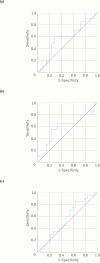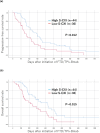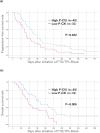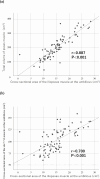Cachexia and efficiency of trifluridine/thymidine phosphorylase inhibitor + bevacizumab in metastatic colorectal cancer
- PMID: 39468284
- PMCID: PMC11519590
- DOI: 10.1038/s41598-024-77766-z
Cachexia and efficiency of trifluridine/thymidine phosphorylase inhibitor + bevacizumab in metastatic colorectal cancer
Abstract
In later-line treatment of metastatic colorectal cancer (mCRC), there may be large differences in treatment efficacy depending on cancer cachexia. Recently, the cachexia index (CXI), which was calculated from the skeletal muscle mass index (SMI), serum albumin concentration, and neutrophil-to-lymphocyte ratio, was developed to evaluate cancer cachexia. We retrospectively examined the CXI of 80 patients who were treated with trifluridine/thymidine phosphorylase inhibitor (FTD/TPI) + bevacizumab (Bmab) therapy as a later-line treatment for mCRC, and assessed the impact of cancer cachexia on chemotherapeutic efficacy using CXI. Progression-free and overall survival rates were significantly worse in the low CXI group than in the high CXI group, although there were no marked differences in tumor factors, such as the number of metastatic organs or gene mutations, between the two groups. As the cross-sectional area of the iliopsoas muscle was significantly associated with that of the skeletal muscle, the accuracy of the CXI based on the psoas mass index (P-CXI), which is easier to calculate than the SMI, in predicting treatment outcomes was equivalent to that of the CXI based on the SMI (S-CXI). Cancer cachexia is an important factor related to treatment efficacy in later-line treatments, such as FTD/TPI + Bmab therapy.
Keywords: Bevacizumab; CXI; Cachexia; Colorectal cancer; FTD/TPI.
© 2024. The Author(s).
Conflict of interest statement
The authors declare no competing interests.
Figures






References
-
- Mayer, R. J. et al. Randomized trial of TAS-102 for refractory metastatic colorectal cancer. N Engl. J. Med.372, 1909–1919 (2015). - PubMed
-
- Prager, G. W. et al. SUNLIGHT Investigators. Trifluridine-Tipiracil and Bevacizumab in Refractory Metastatic Colorectal Cancer. N Engl. J. Med.388, 1657–1667 (2023). - PubMed
-
- Shibutani, M. et al. Combining Bevacizumab With Trifluridine/Thymidine Phosphorylase Inhibitor Improves the Survival Outcomes Regardless of the Usage History of Bevacizumab in Front-line Treatment of Patients With Metastatic Colorectal Cancer. Anticancer Res.40, 4157–4163 (2020). - PubMed
-
- Fearon, K. et al. Definition and classification of cancer cachexia: an international consensus. Lancet Oncol.12, 489–495 (2011). - PubMed
MeSH terms
Substances
LinkOut - more resources
Full Text Sources
Medical
Research Materials
Miscellaneous

